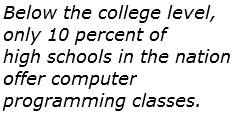As I sit here typing this article I have a laptop to my right connected to a desktop screen that sits directly in front of me. I can multitask easily with this set up, allowing me to write an article on one screen while having another with which to pull up necessary research info. All of my coworkers have the same combination on their desks. If that isn’t enough, my iPhone usually sits nearby as well for when I really want a technology overload.
This isn’t a humble brag. It’s an illustration of how many Americans can tend to take for granted the prevalence of high tech devices waiting at their fingertips. I’m lucky in the sense that, when I need it, technology is there for me. Not everyone in America can say that, however, as about 20 percent of U.S. homes still have no access to the Internet according to a report from George Washington University.
Not everyone in the world can say that they’re inundated with technology, either. Only about a third of the world is connected to the Internet according to a report from the International Teleommunications Union (ITU). The Broadband Commission for Digital Development crafted an open letter calling on the countries of the world to “make the necessary investments to enable their citizens to participate in and benefit from the digital economy and global innovation — or risk exclusion.”
Technology can be transformative, especially when used to elevate and spread knowledge. Many schools and companies are experimenting with massive open online courses (MOOCs) and other forms of online education technology. Offering free educational courses has the potential to bring topics and teachers to different parts of the world, expanding the reach of ideas and discussions.
Once in a generation
 When critics discuss MOOCs they often cite the terrible completion rates the platform has. When Duke University offered a Coursera-delivered course in bioelectricity in Fall of 2012, the school found that out of 12,000 total students enrolled, approximately 8,000 exited the program by the end of the first week.
When critics discuss MOOCs they often cite the terrible completion rates the platform has. When Duke University offered a Coursera-delivered course in bioelectricity in Fall of 2012, the school found that out of 12,000 total students enrolled, approximately 8,000 exited the program by the end of the first week.
On a similar note, a 2014 report from Harvard and MIT on 17 MOOCs offered via edX found that, out of 841,600 registrants, 5 percent got a certificate of completion.
Part of why these numbers look as bad as they do is because of the way online classes are delivered and administered. MOOCs are taking hold in the U.S. partly because they allow people to learn in their own time without having to worry about the repercussions of dropping a class before completion, which contributes to the large exit rates on online courses across various platforms. Someone may realize that they have learned all that they wanted, or that the class just is not for them. Taking a MOOC can allow for this kind of scholastic interaction.
Kepler University
This dynamic may change if MOOCs are used to supplement formal education. Kepler University is using this model in Rwanda to reach a larger number of students. The first of its kind, Kepler merges MOOCs, lecture-style courses and employment training to build a campus experience in the developing world for an affordable price.
On its website, Kepler quotes from Why Nations Fail by James A. Robinson and Daron Acemoglu that best describes their mission:
“The price nations pay for low education of their population is high. They have many potential Bill Gateses and perhaps one or two Albert Einsteins who are now working as poor, uneducated farmers because they never had the opportunity to realize their vocation in life.”
These MOOCs have the opportunity to grow as more internet connections are added to rural areas of Rwanda. According to a presentation made by the Rwanda Development Board to the United Nations Conference on Trade and Development, the country is making inroads to building a proper infrastructure for internet access. Their main foci in bridging the digital divide are:
- Promoting universal access to computers in and out of schools
- Making broadband more affordable for citizens
- Connecting homes to broadband internet
Who knows what knowledge is awaiting release in the minds of students in developing nations unless they have the quality education to help them unlock it? Both the government and the private sector of Rwanda seem to be invested in changing the way that internet access is distributed in the country. If every student cannot be brought to school, maybe we can still bring school to every student.
Educational collaboration and international application
Blended learning, the combination of online and on-campus style of classroom, is a new way to reach students but may have an opportunity to become successful with this experiment. According to Kepler University’s website, 5 percent of the population of Africa is able to afford education. Only 40 percent of the wealthy individuals who go to school end up graduating. There is a chance to raise these numbers and provide the continent, and, eventually, the developing world, with quality, affordable education.
Kepler is also partnered with College for America, a nonprofit college geared towards adults in the workforce, and students are offered duel enrollment, allowing them to move on and earn a degree through competency-based education from an accredited American institution.
While Kepler is only offering an associate degree in general studies with a concentration in business to start, students who completes the program may be able to earn a bachelor’s degree in communications or healthcare management through the partnership with College for America.
Kepler’s blended education strategy
Kepler provides a four-tiered approach to their educational aspirations:
- Students view courses through MOOC platforms and complete online assignments and tests.
- Students live together in a dorm atmosphere in order to facilitate discussion and peer learning.
- Teachers help students participate in group discussions on ideas, follow performance and provide any necessary guidance.
- The school help students connect with employers through internships and helps build skills for employment.
The reach of educational technology
If this model proves itself to work in Rwanda then it could potentially be emulated in other developing countries. It can also benefit American educators by having them tailor their lessons and courses toward other cultures. In this way teachers have the opportunity to learn as they educate students around the world. The reach of technology can be astounding if we use it well and wisely.
Sources:
“20% of American Households Still Offline,” Face the Facts USA, August 15, 2013, http://www.facethefactsusa.org/facts/20percent-of-American-Households-Still-Offline
“One-Third Of World’s Population Using Internet, Developing Nations Showing Biggest Gains,” Maya Shwayder, International Business Times, September 24, 2012,
“Bioelectricity: A Quantitative Approach, Duke University’s First MOOC,” Duke University, February 5, 2013, http://dukespace.lib.duke.edu/dspace/bitstream/handle/10161/6216/Duke_Bioelectricity_MOOC_Fall2012.pdf
“HarvardX and MITx: The First Year of Open Online Courses, Fall 2012-Summer 2013,” Social Science Research Network, June 23, 2014
http://www.ibtimes.com/one-third-worlds-population-using-internet-developing-nations-showing-biggest-gains-795299
“Broadband Commission Open Letter to G20: Bring broadband to the world,” International Telecommunication Union, June 15, 2012,
http://www.itu.int/net/pressoffice/press_releases/2012/39.aspx#.U4UBroY_zzo
Kepler University, http://kepler.org/context/
“Broadband for an inclusive digital society:” a presentation to CSTD 2012-2013 Inter-Sessional Panel Lima, Peru (UNCTAD), Rwanda Development Board, 2012, http://unctad.org/meetings/en/Contribution/Broadband%20for%20an%20inclusive%20digital%20society%20-%20Rwanda.pdf

